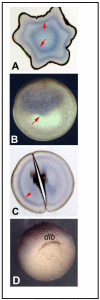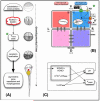KCNQ1 and KCNE1 K+ channel components are involved in early left-right patterning in Xenopus laevis embryos
- PMID: 18453744
- PMCID: PMC3632048
- DOI: 10.1159/000129628
KCNQ1 and KCNE1 K+ channel components are involved in early left-right patterning in Xenopus laevis embryos
Abstract
Several ion transporters have been implicated in left-right (LR) patterning. Here, we characterize a new component of the early bioelectrical circuit: the potassium channel KCNQ1 and its accessory subunit KCNE1. Having cloned the native Xenopus versions of both genes, we show that both are asymmetrically localized as maternal proteins during the first few cleavages of frog embryo development in a process dependent on microtubule and actin organization. Molecular loss-of-function using dominant negative constructs demonstrates that both gene products are required for normal LR asymmetry. We propose a model whereby these channels provide an exit path for K(+) ions brought in by the H(+),K(+)-ATPase. This physiological module thus allows the obligate but electroneutral H(+),K(+)-ATPase to generate an asymmetric voltage gradient on the left and right sides. Our data reveal a new, bioelectrical component of the mechanisms patterning a large-scale axis in vertebrate embryogenesis.
(c) 2008 S. Karger AG, Basel.
Figures







Similar articles
-
H,K-ATPase protein localization and Kir4.1 function reveal concordance of three axes during early determination of left-right asymmetry.Mech Dev. 2008 Mar-Apr;125(3-4):353-72. doi: 10.1016/j.mod.2007.10.011. Epub 2007 Nov 4. Mech Dev. 2008. PMID: 18160269 Free PMC article.
-
Rab GTPases are required for early orientation of the left-right axis in Xenopus.Mech Dev. 2013 Apr-May;130(4-5):254-71. doi: 10.1016/j.mod.2012.11.007. Epub 2013 Jan 23. Mech Dev. 2013. PMID: 23354119 Free PMC article.
-
Ginsenoside Rg3 activates human KCNQ1 K+ channel currents through interacting with the K318 and V319 residues: a role of KCNE1 subunit.Eur J Pharmacol. 2010 Jul 10;637(1-3):138-47. doi: 10.1016/j.ejphar.2010.04.001. Epub 2010 Apr 21. Eur J Pharmacol. 2010. PMID: 20399767
-
Insights into Cardiac IKs (KCNQ1/KCNE1) Channels Regulation.Int J Mol Sci. 2020 Dec 11;21(24):9440. doi: 10.3390/ijms21249440. Int J Mol Sci. 2020. PMID: 33322401 Free PMC article. Review.
-
The membrane protein KCNQ1 potassium ion channel: Functional diversity and current structural insights.Biochim Biophys Acta Biomembr. 2020 May 1;1862(5):183148. doi: 10.1016/j.bbamem.2019.183148. Epub 2019 Dec 9. Biochim Biophys Acta Biomembr. 2020. PMID: 31825788 Free PMC article. Review.
Cited by
-
Long-range gap junctional signaling controls oncogene-mediated tumorigenesis in Xenopus laevis embryos.Front Physiol. 2015 Jan 19;5:519. doi: 10.3389/fphys.2014.00519. eCollection 2014. Front Physiol. 2015. PMID: 25646081 Free PMC article.
-
Bioelectric mechanisms in regeneration: Unique aspects and future perspectives.Semin Cell Dev Biol. 2009 Jul;20(5):543-56. doi: 10.1016/j.semcdb.2009.04.013. Epub 2009 May 3. Semin Cell Dev Biol. 2009. PMID: 19406249 Free PMC article. Review.
-
Differential expression of KCNQ1 K+ channel in tubular cells of frog kidney.Eur J Histochem. 2010 Feb 8;54(1):e7. doi: 10.4081/ejh.2010.e7. Eur J Histochem. 2010. PMID: 20353914 Free PMC article.
-
Biofield Physiology: A Framework for an Emerging Discipline.Glob Adv Health Med. 2015 Nov;4(Suppl):35-41. doi: 10.7453/gahmj.2015.015.suppl. Epub 2015 Nov 1. Glob Adv Health Med. 2015. PMID: 26665040 Free PMC article. Review.
-
Symmetry breakage in the vertebrate embryo: when does it happen and how does it work?Dev Biol. 2014 Sep 1;393(1):109-23. doi: 10.1016/j.ydbio.2014.06.014. Epub 2014 Jun 24. Dev Biol. 2014. PMID: 24972089 Free PMC article. Review.
References
-
- McCaig CD, Rajnicek AM, Song B, Zhao M. Controlling cell behavior electrically: Current views and future potential. Physiol Rev. 2005;85:943–978. - PubMed
-
- Levin M. Large-scale biophysics: Ion flows and regeneration. Trends Cell Biol. 2007;17:262–271. - PubMed
-
- Cone CD. Unified theory on the basic mechanism of normal mitotic control and oncogenesis. J Theor Biol. 1971;30:151–181. - PubMed
-
- Levin M. Bioelectromagnetic patterning fields: Roles in embryonic development, regeneration, and neoplasm. Bioelectromagnetics. 2003;24:295–315. - PubMed
-
- Robinson KR, Messerli MA. Left/right, up/down: The role of endogenous electrical fields as directional signals in development, repair and invasion. Bioessays. 2003;25:759–766. - PubMed
Publication types
MeSH terms
Substances
Grants and funding
LinkOut - more resources
Full Text Sources
